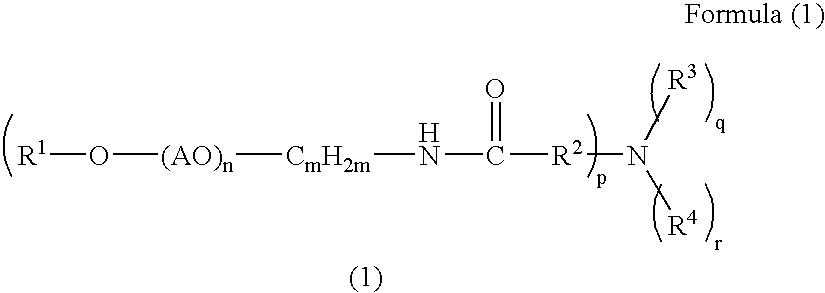Hair cosmetic, aminocarboxylic acid amide and method for producing the same
a technology of aminocarboxylic acid amide and hair, which is applied in the field of hair cosmetics, can solve the problems of insufficient satisfaction of working feeling, inability to satisfy, and inability to satisfy the compatibility between touch and feel, and achieve the effect of sufficient flexibility
- Summary
- Abstract
- Description
- Claims
- Application Information
AI Technical Summary
Benefits of technology
Problems solved by technology
Method used
Image
Examples
synthetic example 2
A four-necks-flask equipped with a stirrer, a temperature gage, a dehydrating pipe and a dropping funnel was charged with 325.6 g of Nissan Amine VBS (alkyl primary amine, manufactured by NOF Corporation), 900 g of methanol and 3.9 g of a methanol solution of 28% sodium methylate as a catalyst. 113.9 g of methyl chloroacetate was added dropwise to the mixture in one hour while the mixture was kept at 15 to 20° C. and the mixture was reacted for 30 hours. After the reaction was completed, the precipitated crystal was filtered and washed with 300 g of methanol, followed by drying to obtain 378.0 g of a corresponding chloroacetamide.
Next, a four-necks-flask equipped with a stirrer, a temperature gage and a cooling tube was charged with 201.0 g of the above chloroacetamide, 219.4 g of diethylamine and 500 g of isopropyl alcohol and the mixture was reacted at 50° C. for 5 hours. After the reaction was completed, 41.7 g of an aqueous 48% sodium hydroxide solution and 100 g of ion excha...
synthetic example 3
A four-necks-flask equipped with a stirrer, a temperature gage, a dehydrating pipe and a nitrogen-introducing pipe was charged with 370.7 g of Firmine 20 (alkyl primary amine, manufactured by Kao Corporation) and 147.1 g of N-methyliminodiacetic acid. The mixture was reacted at 180° C. for 10 hours while generated water was distilled. Then, the reaction solution was subjected to crystallization using acetone, followed by drying to obtain 476.4 g of an amine C shown in Table 1.
synthetic example 4
The same starting material and conditions as in Synthetic Example 2 were used except that 258.2 g of Firmine 86T (alkyl primary amine, manufactured by Kao Corporation) was used in place of Nissan VBS, to obtain 316.0 g of chloroacetamide.
Next, a four-necks-flask equipped with a stirrer, a temperature gage and a cooling tube was charged with 167.3 g of the above chloroacetamide, 187.8 g of methyl ethanol amine and 500 g of methanol and the mixture was reacted at 35 to 45° C. for 13 hours. After the reaction was completed, 41.7 g of an aqueous 48% sodium hydroxide solution was added to the reaction mixture. Thereafter, excess methyl ethanol amine and solvents were distilled under reduced pressure. Further, the residue was desalted and crystallized using acetone, followed by drying to obtain 328.5 g of an amine D shown in Table 1.
TABLE 1Amine AAmine BAmine CAmine D
PUM
| Property | Measurement | Unit |
|---|---|---|
| composition | aaaaa | aaaaa |
| flexibility | aaaaa | aaaaa |
| smoothness | aaaaa | aaaaa |
Abstract
Description
Claims
Application Information
 Login to View More
Login to View More - R&D Engineer
- R&D Manager
- IP Professional
- Industry Leading Data Capabilities
- Powerful AI technology
- Patent DNA Extraction
Browse by: Latest US Patents, China's latest patents, Technical Efficacy Thesaurus, Application Domain, Technology Topic, Popular Technical Reports.
© 2024 PatSnap. All rights reserved.Legal|Privacy policy|Modern Slavery Act Transparency Statement|Sitemap|About US| Contact US: help@patsnap.com










